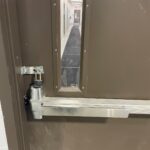I’ve been doing some research for my FDAI presentation, looking for specific examples of how the inspection of fire doors and correction of deficiencies can have a direct impact on life safety as well as the protection of property. It’s not very often that you see fire doors in the news, but these two recent examples showed up over the holidays:
300 forced out by fire – 12/16/10 – The Standard
“Mehlenbacher was hopeful people in 40 of the 112 units that were well protected by fire doors would be able to return home by late Wednesday…He said a self-closing door in the affected apartment appears not to have worked properly and didn’t shut completely.”
Three injured, one critically, in early morning Fall River fire – 12/21/10 – The Boston Herald
“When they fled, the door to their apartment remained open and the fire followed them out, rushing up the stairwell… There were two stairways available to the third floor residents. One was filled with flames from the burning apartment. The second was filled with dense black smoke.”
And I don’t know how I missed this one, but it’s a very interesting video about the fire doors in the Staples Center. Enjoy!
If you run across any news reports that mention fire doors or blocked exits, please send me a link!
You need to login or register to bookmark/favorite this content.






Lori,
From the article in “The Standard”, did you notice the fire “likely started on a scooter that was being recharged”?
Are we in for a rash of fires caused by electric vehicles being recharged in enclosed garages?
I did notice that…I think the scooter was actually in the apartment rather than in a garage. I think it’s probably an isolated incident but you never know. Even more reason to have working fire doors, not to mention sprinklers.
Lori,
Do you remember the fire last year that destroyed Neil Young’s hybrid car? Found this update:
Neil Young’s Warehouse Fire
He adds, “The LincVolt (car) suffered a disastrous accidental fire stemming from human error. The car was plugged in to charge and left unattended. The wall charging system was not completely tested and had never been left unattended. A mistake was made. It was not the fault of the car.”
I’m not sure there are many residences that have a fire door between the enclosed garage and the residence. Do we anticipate that this (installation of a fire door) will be a requirement when plug-in hybrids are purchased and stored in your garage?
I don’t remember seeing anything in the news on that fire, but most jurisdictions require some level of protection between the house and attached garage. I did a post on this a while back, which includes the text from the International Residential Code: http://idighardware.com/2009/03/residential-fire-doors/
This is a real issue:
The Neil Young fire: http://wheels.blogs.nytimes.com/2010/11/16/neil-youngs-hybrid-lincvolt-survives-fire/
http://abcnews.go.com/blogs/headlines/2011/11/after-n-c-fire-duke-energy-advises-customers-to-suspend-use-of-electric-car-chargers/
http://www.hybridcars.com/news/gm-will-replace-chevy-volt-charging-cords-43136.html
It also looks like the public has concerns that parallel ours.
http://www.hybridcars.com/news/ode-share-consumer-reports-releases-plug-vehicle-survey-results-says-volt-incident-misguided-ge
Recently I read a book about one of the first major oil and gas barons here in the US. He discovered that oil could run internal combustion engines, and therefore tried to talk the railroads into switching from their steam powered locomotives. His first two prototype locomotive burned up, yet engineering overcame the risk and now it is common place to find crude oil originated power.